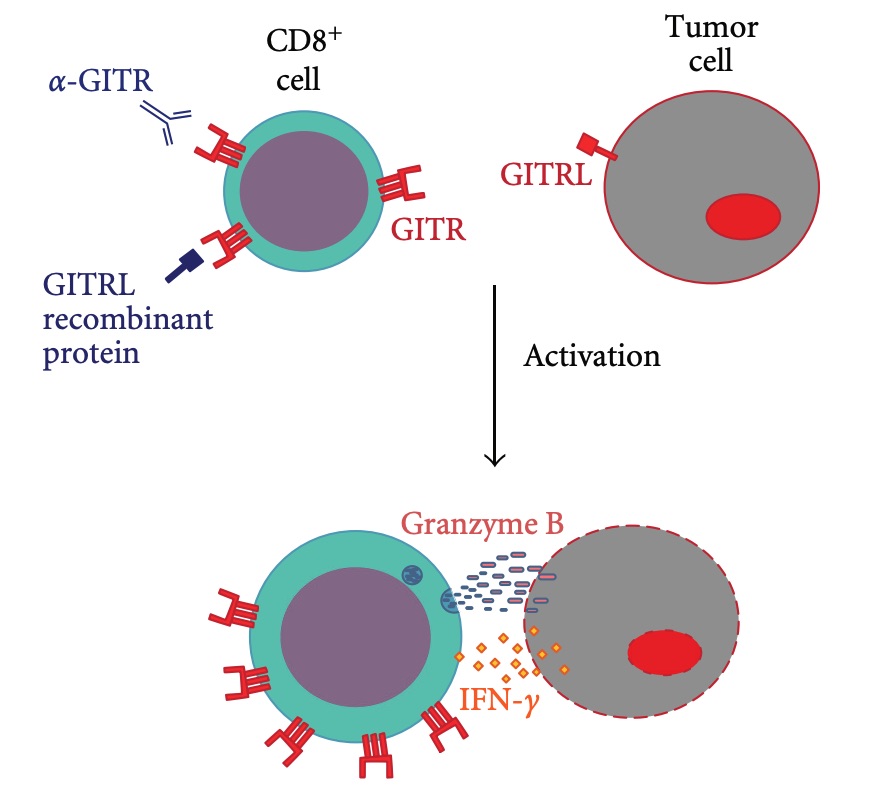Hi-Affi™ hPD-L1/hGITR Dual Humanized Mouse Model
Human glucocorticoid-induced tumor necrosis factor receptor (hGITR) is a costimulatory molecule that immunologists are keen to study. Activating the hGITR could down-regulate the inhibitory activity of regulatory T cells (Tregs) and prolong the survival of effector T cells (Teffs). The anti-hGITR agonistic antibody can enhance the efficacy of the anti-hPD-L1 antibody, thus the combination of these two different antibodies might be an effective therapy clinically. Creative Biolabs has successfully established an optimized Hi-Affi™ “humanized” animal platform to offer specialty manipulated hPD-L1/hGITR dual humanized mice for our clients all over the world.
hPD-L1/hGITR Molecule
Human programmed cell death-ligand 1 (hPD-L1) expressed on tumor cells could interact with human programmed cell death protein 1 (hPD-1) which is the receptor of hPD-L1. When these two molecules (hPD-1 and hPD-L1) are combined, they provide an inhibitory signal that inhibits the activation and proliferation of antigen-specific cytotoxic T cells.
hGITR is the 18th member of the tumor necrosis factor receptor superfamily (TNFRSF). It has high-level expression on the surface of Tregs, while relatively low-level expression on the surface of Teffs. When Teffs are activated, the expression level of hGITR will increase rapidly in a short time.
 Fig. 1 GITR function in antitumoral immunity. 1
Fig. 1 GITR function in antitumoral immunity. 1
hPD-L1/hGITR Signal Pathway
To prevent T cells from being overstimulated, there are negative signal pathways that regulate T cells, such as the hPD-1/hPD-L1 pathway. The expression of hPD-L1 can be induced on tumor cells by the microenvironment at the tumor site. The expressed hPD-L1 is conducive to the occurrence and growth of tumors and induces the apoptosis of anti-tumor T cells. The anti-hPD-L1 antibody blocks the hPD-1/hPD-L1 signaling pathway which transmits negative regulatory signals and restores the activity of T cells, thereby enhancing the immune response.
The hGITR pathway has different functions in Tregs and Teffs. Activating the hGITR on the surface of Teffs can promote the proliferation and survival of Teffs. And Teffs are the main force to destroy tumor cells on the front line. If the activity and quantity of Teffs can be improved, it is possible to improve the effects of existing immunotherapy (such as anti-hPD-L1 antibody therapy). At the same time, when an agonist antibody binds to hGITR on the surface of Tregs, the hGITR pathway can promote Tregs failure. Tregs which inhibit the function of Teffs, thus, inducing their failure indirectly plays a role in activating the function of Teffs.
Development of hPD-L1/hGITR Dual Humanized Mice
As an important target for tumor immunotherapy, studies have shown that hGITR can not only enhance the proliferation of Teffs and tumor-killing activity, hGITR activation also blocks the inhibitory effect of Treg cells. Activating hGITR is a two-pronged approach to enhance immune function, which makes it a promising candidate to be in combination with the anti-hPD-L1 antibody for cancer treatment. As a professional CRO company, Creative Biolabs has accumulated much experience in preclinical drug development. We have assisted our global clients in their research using our successfully established Hi-Affi™ “humanized” animal models. If you are interested in these humanized mice, please feel free to contact us for more details.
Creative Biolabs also offers other various Humanized Mouse Models you may be interested in:
Reference
- Ronchetti, Simona, et al. "CD8+ T cells: GITR matters." The Scientific World Journal 2012.1 (2012): 308265. Distributed under Open Access license CC BY 4.0, without modification.
For Research Use Only.
